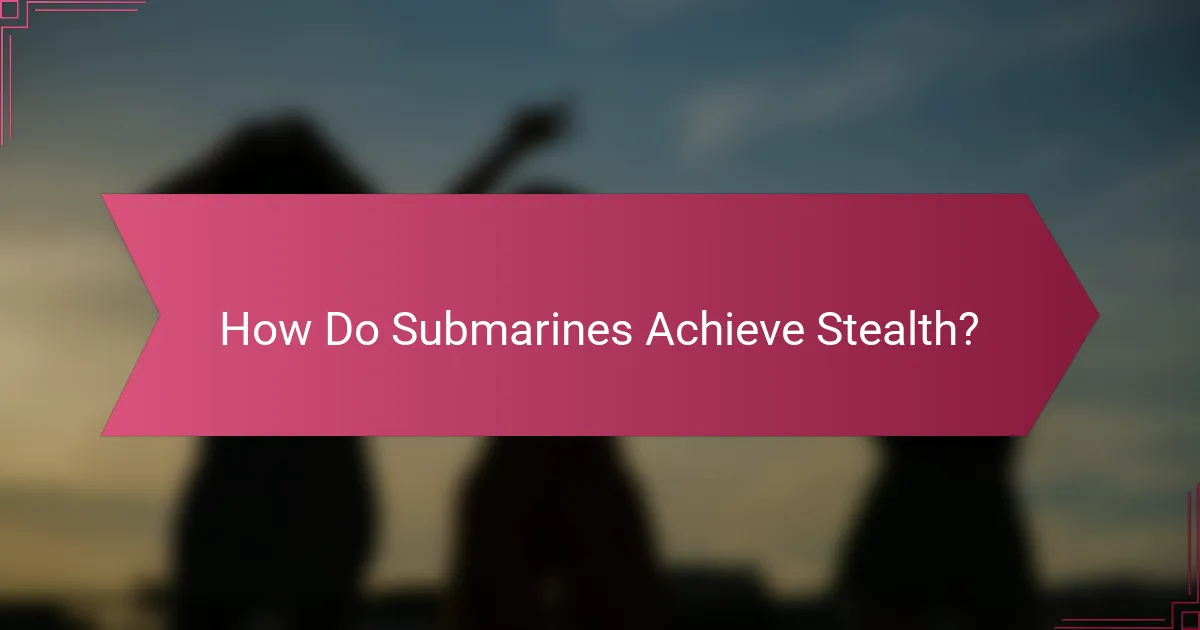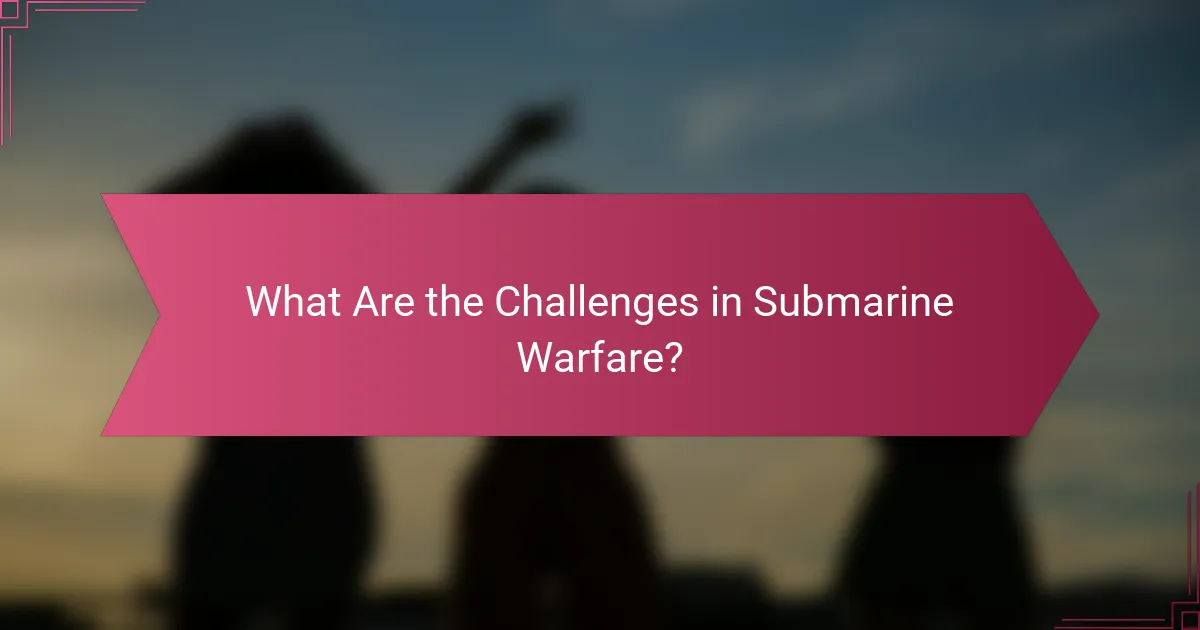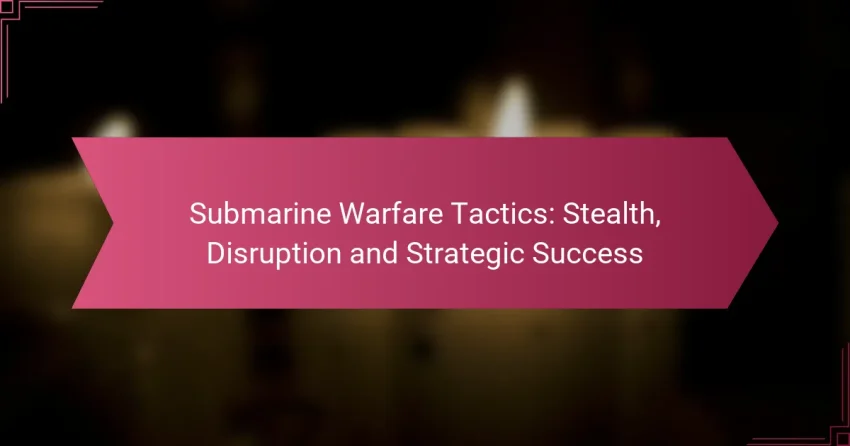Effective submarine warfare tactics are centered on achieving stealth, disruption, and strategic success, allowing submarines to gain a decisive edge in naval conflicts. By utilizing advanced technologies and design features, submarines can operate undetected, executing missions that significantly disrupt enemy operations and enhance their own chances of success.

What Are Effective Submarine Warfare Tactics?
Effective submarine warfare tactics focus on stealth, disruption, and strategic success to gain an advantage in naval engagements. These tactics leverage the unique capabilities of submarines to operate undetected while executing missions that can significantly impact enemy operations.
Stealth Operations
Stealth operations are crucial for submarines to avoid detection and maintain a tactical advantage. Submarines employ advanced technologies such as sound-dampening materials and quiet propulsion systems to minimize noise and reduce their acoustic signature.
Effective stealth also involves careful planning of routes and operational depths. Submarines often operate at periscope depth or deeper to avoid sonar detection, using natural underwater features to mask their presence.
Disruption Techniques
Disruption techniques aim to create confusion and hinder enemy operations. Submarines can launch torpedoes or missiles to target key vessels, disrupting supply lines and command structures.
Additionally, submarines can use decoys and electronic warfare to mislead enemy sensors. This can involve deploying false targets or jamming communications, thereby creating opportunities for surprise attacks.
Strategic Maneuvering
Strategic maneuvering involves positioning submarines to maximize their effectiveness while minimizing risk. Submarines often utilize underwater currents and terrain to navigate stealthily and approach targets undetected.
Effective maneuvering requires constant assessment of the operational environment and enemy movements. Submarines must be prepared to change course quickly to avoid detection or engage targets opportunistically.
Intelligence Gathering
Intelligence gathering is a vital component of submarine warfare, providing insights into enemy capabilities and intentions. Submarines can collect data through passive sonar, monitoring communications, and conducting reconnaissance missions.
This intelligence can inform strategic decisions and operational planning. Submarines often share gathered intelligence with allied forces to enhance collective situational awareness and operational effectiveness.
Covert Infiltration
Covert infiltration allows submarines to penetrate enemy waters undetected, often for reconnaissance or special operations. This tactic requires careful planning and execution to avoid detection by enemy forces.
Submarines may deploy special forces or conduct sabotage missions against critical infrastructure. Successful infiltration relies on stealth, timing, and the ability to exploit weaknesses in enemy defenses.

How Do Submarines Achieve Stealth?
Submarines achieve stealth through a combination of advanced technologies and design features that minimize their detectability. Key methods include sophisticated sonar systems, noise reduction techniques, and innovative hull designs that help them remain undetected in hostile waters.
Advanced Sonar Technology
Modern submarines utilize advanced sonar technology to detect and avoid threats while remaining hidden. These systems can differentiate between various underwater sounds, allowing submarines to identify enemy vessels and navigate safely.
Active sonar emits sound waves and listens for echoes, but it can reveal a submarine’s position. Therefore, many submarines rely on passive sonar, which only listens for sounds made by other vessels, enhancing stealth.
Noise Reduction Techniques
Noise reduction is crucial for submarine stealth, as any sound can compromise their position. Submarines employ several techniques, such as using sound-absorbing materials in their construction and isolating machinery to minimize vibrations.
Additionally, submarines often operate at slower speeds to reduce noise levels. This trade-off can enhance stealth but may limit their ability to maneuver quickly in combat situations.
Hull Design Innovations
Innovative hull designs significantly contribute to a submarine’s stealth capabilities. Modern submarines often feature streamlined shapes that reduce drag and minimize noise when moving through water.
Some designs incorporate anechoic coatings, which are rubber-like materials that absorb sound waves, further decreasing detectability. These hull innovations allow submarines to operate more quietly and evade detection effectively.

What Disruption Strategies Are Used in Submarine Warfare?
Disruption strategies in submarine warfare aim to confuse, mislead, or incapacitate enemy forces. These tactics enhance stealth operations and increase the chances of strategic success by undermining the opponent’s situational awareness and response capabilities.
Electronic Warfare
Electronic warfare (EW) involves using electromagnetic energy to disrupt enemy radar and communication systems. Submarines can employ jamming techniques to interfere with sonar and radar signals, making it difficult for adversaries to detect their presence.
Key considerations include the timing and intensity of jamming efforts, as excessive use can attract attention. Effective EW requires a deep understanding of enemy systems and the ability to adapt tactics based on real-time feedback.
Decoy Deployment
Decoy deployment is a tactic where submarines use false targets to mislead enemy sensors. This can involve launching decoys that mimic the acoustic signature or radar profile of the submarine, diverting attention and resources away from the actual vessel.
Common decoy types include towed devices and buoyant systems that create noise or reflect signals. The effectiveness of decoys depends on their realism and the enemy’s ability to discern genuine threats from false signals.
Cyber Operations
Cyber operations in submarine warfare focus on disrupting enemy networks and communications through digital means. This can involve hacking into systems to gather intelligence or to disable critical infrastructure that supports naval operations.
Successful cyber tactics require skilled personnel and advanced technology. Submarines must maintain robust cybersecurity measures to protect their own systems while executing offensive operations against adversaries.

How Do Submarines Contribute to Strategic Success?
Submarines play a crucial role in achieving strategic success through their unique capabilities in stealth, force projection, and deterrence. Their ability to operate undetected allows them to influence naval operations and maintain a strategic advantage over adversaries.
Force Projection
Submarines enable force projection by allowing nations to extend their military reach without immediate visibility. They can covertly position themselves near potential conflict zones, ready to launch attacks or gather intelligence. This capability is essential for maintaining a presence in strategic waterways, such as the South China Sea or the Mediterranean.
For effective force projection, submarines often utilize cruise missiles and torpedoes, which can strike targets from significant distances. This allows for a rapid response to emerging threats while minimizing the risk of detection.
Deterrence Capabilities
Submarines serve as a powerful deterrent against potential aggressors. Their stealthy nature makes it difficult for adversaries to track and target them, creating uncertainty about the potential consequences of an attack. This uncertainty can dissuade hostile actions and contribute to regional stability.
Nuclear-powered submarines, in particular, enhance deterrence through second-strike capabilities. Countries like the United States and Russia maintain fleets of ballistic missile submarines to ensure a credible threat against any nuclear aggression, reinforcing the principle of mutually assured destruction.
Asymmetric Warfare
Submarines excel in asymmetric warfare by exploiting their stealth and mobility to counter larger, conventional forces. They can disrupt supply lines, conduct surprise attacks, and gather intelligence without engaging in direct confrontation. This approach allows smaller nations or non-state actors to challenge more powerful adversaries effectively.
For instance, during the Cold War, submarines were used to monitor and disrupt naval operations of superpowers. Modern examples include the use of submarines by various nations to conduct covert operations in contested regions, demonstrating their ongoing relevance in asymmetric strategies.

What Are the Key Technologies in Modern Submarine Warfare?
Modern submarine warfare relies on advanced technologies that enhance stealth, offensive capabilities, and situational awareness. Key technologies include missile systems, unmanned underwater vehicles, and artificial intelligence integration, each playing a critical role in ensuring operational effectiveness.
Missile Systems
Missile systems are a cornerstone of modern submarine warfare, providing submarines with the ability to strike targets from significant distances. These systems typically include cruise missiles, which can be launched while submerged, allowing for stealthy engagements.
Submarines often utilize missiles like the Tomahawk, which can travel over 1,000 kilometers and strike land or sea targets with precision. The integration of vertical launch systems (VLS) allows for rapid reloading and firing of multiple missiles, enhancing a submarine’s offensive capabilities.
Unmanned Underwater Vehicles
Unmanned underwater vehicles (UUVs) are increasingly used in submarine warfare for reconnaissance, surveillance, and mine detection. These autonomous or remotely operated vehicles can operate in environments that may be too risky for manned submarines.
UUVs can be equipped with various sensors and payloads, allowing them to gather intelligence or conduct specific missions without exposing the submarine. Their deployment can significantly enhance a submarine’s operational flexibility and effectiveness in complex maritime environments.
Artificial Intelligence Integration
Artificial intelligence (AI) is transforming submarine warfare by improving decision-making processes and operational efficiency. AI systems can analyze vast amounts of data from sensors and other sources, providing real-time insights that enhance situational awareness.
For instance, AI can assist in threat detection and classification, enabling submarines to respond more quickly to potential dangers. Additionally, AI-driven systems can optimize navigation and mission planning, allowing submarines to execute complex maneuvers with greater precision and reduced risk.

What Are the Challenges in Submarine Warfare?
Submarine warfare presents unique challenges primarily due to the need for stealth and the complexities of underwater operations. Detecting submarines and countering their tactics require advanced technology and strategic planning.
Detection and Countermeasures
Detection of submarines is a significant challenge for naval forces, as submarines are designed to operate stealthily. Various technologies, including sonar systems and satellite surveillance, are employed to locate submerged vessels. However, these systems can be limited by environmental factors such as temperature layers in the ocean and background noise.
Countermeasures against detection include using advanced materials for hull construction that absorb sonar waves, as well as employing tactics like silent running to minimize noise. Submarines may also deploy decoys or utilize electronic warfare to disrupt enemy sensors. Understanding the effectiveness of these countermeasures is crucial for maintaining operational security.
Naval forces must continuously adapt their detection methods to keep pace with evolving submarine technologies. Regular training and investment in new detection systems are essential to enhance capabilities against stealthy underwater threats.
